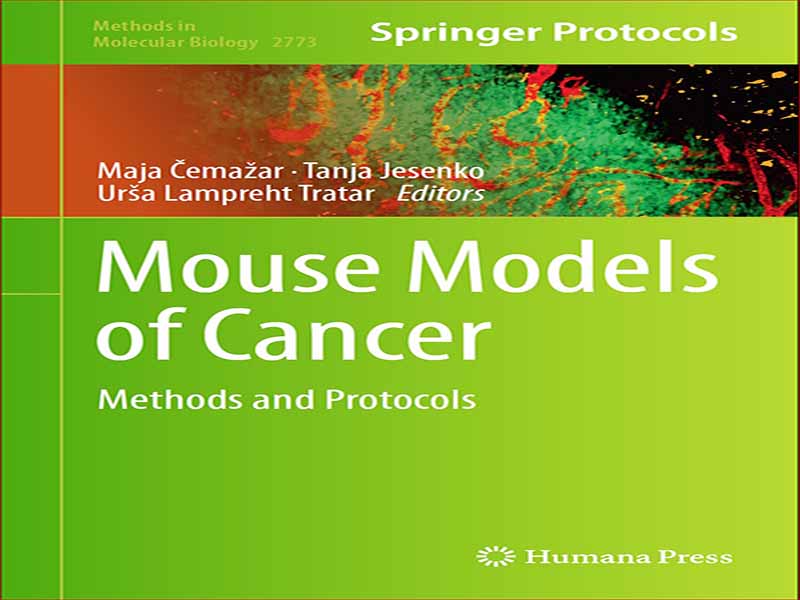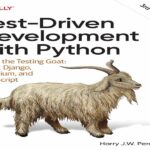- عنوان کتاب: Mouse Models of Cancer
- نویسنده: Maja Cemazar
- حوزه: سرطان
- سال انتشار: 2024
- تعداد صفحه: 201
- زبان اصلی: انگلیسی
- نوع فایل: pdf
- حجم فایل: 10.5 مگابایت
همه چیز در اوایل دهه 1900 در ایالات متحده آمریکا در ماساچوست آغاز شد. این آغاز دوران مدرن استفاده از موش ها در تحقیقات علمی بود، ابتدا برای مطالعات ژنتیکی، اما به زودی برای مطالعات سرطان، به ویژه پس از ایجاد اولین موش همخون، C57Bl/6، که توسط کلارنس کوک لیتل ساخته شد. پس از آن، استفاده از مدلهای موش به طور پیوسته افزایش یافت، زیرا موشها و انسانها حدود 70 درصد از توالیهای ژن کدکننده پروتئین یکسان را به اشتراک میگذارند. مدلهای موش نقش مهمی در تحقیقات سرطان ایفا میکنند، زیرا یک سیستم آزمایشی کنترلشده و قابل تکرار برای مطالعه جنبههای مختلف بیولوژی سرطان، از جمله پیشگیری، توسعه، پیشرفت، و درمان ارائه میکنند، که همگی در سطوح مختلف مورد مطالعه قرار میگیرند: ریزمحیط، محیط مزو (سطح اندام)، و محیط کلان (کل ارگانیسم). این مدلها، که اغلب از نظر ژنتیکی اصلاح شده یا با سلولهای تومور انسانی کاشته میشوند، بینشهایی را در مورد توسعه سرطان ارائه میدهند که بهتنهایی از طریق آزمایشهای بالینی بهسختی به دست میآیند. توسعه استفاده از مدلهای موش در تحقیقات سرطان با استفاده از اصول 3R (جایگزینی، کاهش و اصلاح) بیشتر پیشرفت کرده است. استفاده از اصول 3R در تحقیقات مدل موش سرطانی به اطمینان از انجام تحقیقات اخلاقی کمک می کند و استفاده از حیوانات را با حفظ دقت علمی به حداقل می رساند. علاوه بر این، اجرای دستورالعملهای ARRIVE (گزارشدهی تحقیقات حیوانی در آزمایشهای داخل بدن) و PREPARE (برنامهریزی تحقیقات و روشهای آزمایشی روی حیوانات: توصیههایی برای تعالی) در تحقیقات سرطان موش، کیفیت و ارزش ترجمهای تحقیق را بهبود بخشیده است. مدلهای موش ابزاری غیرقابل جایگزین برای درک رشد و پیشرفت تومور با بررسی چگونگی کمک جهشهای خاص به توسعه و پیشرفت سرطان هستند. مدلهای سرطان موش برای آزمایش درمانهای بالقوه سرطان، از جمله شیمیدرمانی، درمانهای هدفمند و ایمونوتراپی استفاده میشوند. اثربخشی، سمیت و ایمنی درمانهای مختلف را میتوان برای شناسایی نامزدهای امیدوارکننده برای آزمایشهای بیشتر در آزمایشهای بالینی ارزیابی کرد. علاوه بر این، از مدلهای موش میتوان برای مطالعه مکانیسمهای نهفته در مقاومت درمانی استفاده کرد تا بتوان استراتژیهایی برای غلبه بر آن توسعه داد. مدل های ماوس نیز برای مطالعه پزشکی شخصی مناسب هستند. در مدلهای پیوند زنوگرافت مشتق شده از بیمار، بافت تومور انسانی در موش کاشته میشود. این مدلها به محققان اجازه میدهند پاسخ تومور خاص بیمار را به درمانهای مختلف آزمایش کنند و رویکردهای درمانی شخصیسازی شده را تسهیل کنند. علاوه بر این، مدلهای موش را میتوان برای مطالعه تأثیرات عوامل سبک زندگی، تأثیرات محیطی و اقدامات پیشگیرانه بر توسعه سرطان مورد استفاده قرار داد و به توسعه استراتژیهای پیشگیری از سرطان کمک کرد. این کتاب مدلهای مختلفی را برای مطالعات سرطان ارائه میکند، از مدلهای لوسمی و لنفوم گرفته تا انواع مختلف مدلهای زیر جلدی و ارتوتوپی. علاوه بر این، مدلهایی برای فرآیند بهبودی و ارزیابی پاسخ ایمنی پس از درمانهای سایشی موضعی مورد بحث قرار میگیرند. فصول پایانی کتاب به تکنیک های مختلف تصویربرداری می پردازد که امکان تجسم سرطان را در سطوح سلولی و بافتی فراهم می کند. در نهایت، شرح مفصلی از کالبد شکافی توضیح داده شده است، که برای به دست آوردن مواد زیستی خوب برای تحقیقات ترجمه ضروری است.
It all started in the early 1900s in the USA, in Massachusetts. It was the beginning of the modern era of using mice in scientific research, first for genetic studies, but soon after also for cancer studies, especially after the creation of the first inbred mouse, the C57Bl/6, developed by Clarence Cook Little.
Thereafter, the use of mouse models increased steadily, as mice and humans share about 70% of the same protein-coding gene sequences. Mouse models play a crucial role in cancer research as they provide a controlled and reproducible experimental system to study differ-ent aspects of cancer biology, including prevention, development, progression, and treat-ment, all of which are studied at different levels: the microenvironment, the mezzo-environment (organ level), and the macro-environment (whole organism). These models, which are often genetically modified or implanted with human tumor cells, offer insights into cancer development that are difficult to gain through clinical trials alone.
The development of the use of mouse models in cancer research has been further advanced by the application of the 3R (Replacement, Reduction, and Refinement) princi-ples. The application of the 3R principles in cancer mouse model research helps to ensure that research is conducted ethically and minimizes the use of animals while maintaining scientific rigor. In addition, the implementation of ARRIVE (Animal Research Reporting In Vivo Experiments) and PREPARE (Planning Research and Experimental Procedures on Animals: Recommendations for Excellence) guidelines in mouse cancer research has improved the quality and translational value of the research.
Mouse models are an irreplaceable tool for understanding tumor development and progression by investigating how specific mutations contribute to the development and progression of cancer. Mouse cancer models are used to test potential cancer therapies, including chemotherapy, targeted therapies, and immunotherapies. The efficacy, toxicity, and safety of different treatments can be evaluated to identify promising candidates for further testing in clinical trials. In addition, mouse models can be used to study the mechanisms underlying treatment resistance so that strategies can be developed to over-come it. Mouse models are also suitable for the study of personalized medicine. In patient-derived xenograft models, human tumor tissue is implanted into mice. These models allow researchers to test a patient’s specific tumor response to different therapies, facilitating personalized treatment approaches. In addition, mouse models can also be used to study the effects of lifestyle factors, environmental influences, and preventive measures on cancer development, contributing to the development of cancer prevention strategies.
This book presents various models for cancer studies, from leukemia and lymphoma models to different types of subcutaneous and orthotopic models. In addition, models for the healing process and the assessment of the immuneresponse afterlocal ablativetherapies are discussed. The final chapters of the book deal with different imaging techniques that allow visualization of cancer at the cellular and tissue levels. Finally, a detailed description of necropsy is explained, which is essential for obtaining good biomaterial for translational research.
این کتاب را میتوانید بصورت رایگان از لینک زیر دانلود نمایید.
Download: Mouse Models of Cancer




































نظرات کاربران